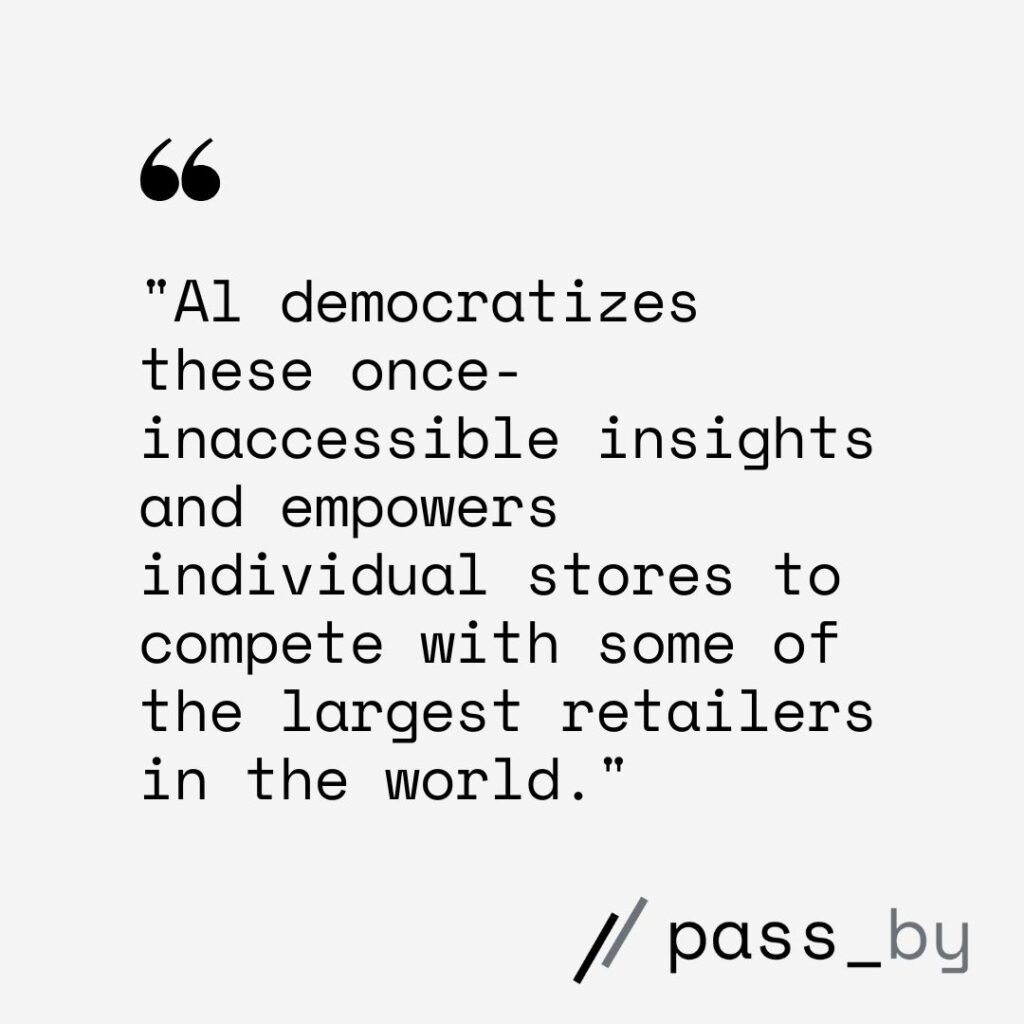The very word ‘retail’ has become synonymous with innovation. Physical retail has had to innovate to evolve to overcome consumer sluggishness, a pandemic, and countless disruptive technologies in the last couple of years alone. The industry’s resilience and progress can largely be attributed to advanced data and predictive analytics systems, which enable data-driven decision-making, strategizing, and, ultimately, overcoming.
Internet of Things (IoT) technologies and artificial intelligence (AI) provide valuable store insights. AI gives businesses unparalleled access to high-level organized data, leading to improved retail operations, new business opportunities, and more seamless in-store experiences. It is no wonder that AI has driven an additional estimated $40 billion in revenue for the retail industry over a 3-year period.
Now, as physical retail finds its feet and begins surpassing pre-pandemic performance, AI is doing more than simply keeping stores afloat. AI technologies are helping retail businesses become more competitive than ever before.
READ MORE: Generative AI’s Effect On Brick-And-Mortar Retail
Insights Into Competitor Performance
AI-driven competitive insights enable retailers to take their insights for their own stores and access that same view for their competitors. Technology leaders in this category offer competitive data sets that enable customers to analyze what is working for their competitors at a store level and in their trade areas. This information can be utilized for strategic planning, store operations, real estate, marketing, and more.
This level of insight previously required extensive data ingestion and teams of data scientists to comprehend competitive performance, assuming that data was even accessible. Now, with the help of new technologies, this process has been simplified. At pass_by, this is done by measuring foot traffic to thousands of US brands and augmenting the foot traffic with over 10 unique demographic and psychographic datasets to provide unique insights into competitive performance.
The newest foot traffic model can overlay intricate psychographic and demographic data onto foot traffic data to offer previously unavailable competitive insights. Previous attempts to do this have often been unreliable, messy, and simply incorrect. This streamlined, ultra-accurate data then enables competitive intelligence across several different teams, from store ops to real estate. Moreover, AI is added into the mix to provide a predictive element to this model, allowing retailers to view forecasts of future performance patterns months into the future.
Ultimately, this technology allows retailers to enjoy the same richness of their first-party data, but with regard to their competitors. This presents the new frontier in in-store analytics wherein foot traffic is taken to new heights with a layered look into how competitor brands are performing now and into the future.
Empowering Retail Workers
In the past, obtaining precise predictions and gaining competitive insights would have required a more manual data science approach, likely involving some form of machine learning (ML) and large teams of data scientists. However, with more advanced models, it’s possible for the models to ‘learn’ and use this capability not only to measure more accurately but also to assist retailers in predicting future events. This is where AI can be beneficial in supporting workers’ goals and innovation initiatives.

Massively time-consuming tasks like data management and processing can now be executed accurately by AI, thereby lightening the load on the labor force. Critically, AI enables the rapid processing of raw data, making it accessible to workers in a manageable and actionable format. As a result, AI democratizes these once-inaccessible insights and empowers individual stores to compete with some of the largest retailers in the world.
For example, AI-processed insights can be shared with store teams ahead of peak shopping periods or key occasions. These learnings and predictions can help brands anticipate which of their stores will see an increase in foot traffic, allowing them to plan ahead and adjust their staff allocation to maximize customer satisfaction.
WATCH NOW: Retail Leaders On The Power Of In-Store Analytics
Busting AI Myths
Whenever a new technology is introduced, there has been a heady mix of concern, excitement, and trepidation. From the first factory to the smartphone, innovation ushers in anxiety. AI has not been immune from these reactions. According to Forbes, some key AI concerns are privacy, bias, job displacement, economic inequality, and manipulation.
However, AI is central to the evolution of in-store analytics and, in turn, physical retail. AI allows brick-and-mortar stores to stay competitive (with one another and their online counterparts), deliver experiences that surprise and delight, and better serve shoppers in ways that are frictionless, convenient, and responsive. AI is a helpful tool that assists retailers in processing the ocean of data collected in stores and repackaging it into actionable insights for store teams.
The responsible, ethical use of AI will mark a new chapter for retail. Here are the two most popular myths about AI in the retail industry, and why they’re incorrect:
1. “AI strips shoppers of their privacy”
The demographic data used in top-notch models is strictly regulated to ensure privacy and compliance with data protection laws. At pass_by, models can infer the demographic profile of store visitors without using data tied to any individual. Instead, the models use statistically weighted demographic inputs to provide retailers with insights into the likely demographic breakdown of visits to their stores, as well as for the malls and neighborhoods they are located in, and for their key competitors. The goal is to offer valuable insights while upholding the highest standards of data privacy and security.
Of course, this all starts with CCPA- and GDPR-compliant in-store analytics. The data itself must be ethically collected to ensure the ethical use of data. It is retailers’ responsibility to collaborate with technology partners that take privacy seriously. Before AI can work its proverbial magic, store data must be accurate, reliable, and privacy-friendly.
2. “AI is taking jobs away from retail workers”
AI is not about taking retail workers’ jobs. It’s about understanding and processing huge amounts of data and reducing the time it takes to answer questions that retailers need to answer in order to succeed. AI-driven competitive insights help retail workers by predicting future demand, aiding in-store operations planning, understanding customer demographics, and identifying performance trends within and across store chains. This information allows workers to focus on strategic tasks, improve customer service, and implement best practices from top-performing stores. Ultimately, AI reduces the workload by providing clear, actionable insights that guide day-to-day operations and long-term planning.
These competitive insights also help put the performance of retailers’ stores into perspective. Suppose a particular store is seeing a large increase or decrease in traffic or a change in demographics. In that case, the data can help provide context by analyzing what’s happening around that store, such as the mall the store is located in or the nearby competitors. This helps eliminate uncertainty for retail workers by providing them with high-quality, relevant information to excel in their roles.
AI is revolutionizing the retail industry by offering unprecedented insights and capabilities that were previously unimaginable. It enables retailers to harness vast amounts of data to make informed decisions, optimize operations, and gain a competitive edge. The ability to comprehend both their own performance and that of their competitors in real-time provides a significant advantage to retailers, enabling strategic planning and improved customer service.
Moreover, AI is not about replacing retail workers but empowering them. By automating repetitive tasks and providing clear, actionable insights, AI frees up employees to focus on higher-level strategic initiatives and improve overall store performance. This technology democratizes data access, ensuring even smaller retailers can compete effectively with larger chains.
While concerns around AI, such as privacy and job displacement, persist, the responsible and ethical use of AI in retail demonstrates that these fears can be mitigated. AI-driven solutions are designed to comply with stringent data protection regulations, ensuring that customer privacy is maintained. As AI continues to evolve, its role in retail will likely expand, driving further innovation and efficiency within the industry. The integration of AI into retail is not just a trend but a fundamental shift towards a more data-driven and competitive future.
READ THE PRESS RELEASE: RetailNext And pass_by Announce Partnership





